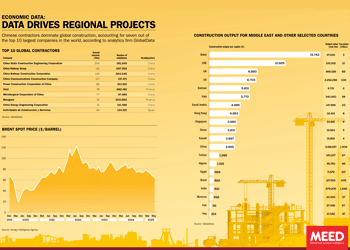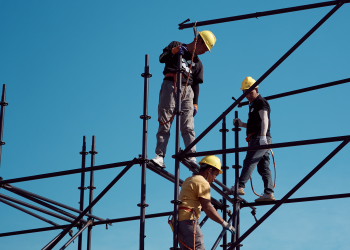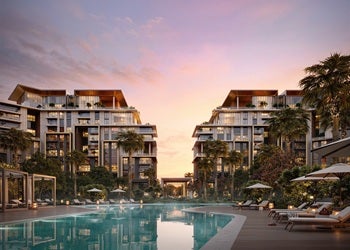Top pending projects in 2024
27 December 2023

This report on 2024 projects also includes: Upcoming regional projects hit $270bn
| $17.6bn |
Neom City Development Programme
Project client: Neom
Since its launch in 2017, Saudi Arabia’s Neom has announced numerous masterplans – among them the 170-kilometre-long The Line, the partly offshore industrial city Oxagon and the Trojena mountain resort. These projects make up a large part of the $17.6bn of work currently under bid within the gigaproject.
As the $500bn gigaproject becomes a busy construction site, the construction industry has started to benefit from a sharp increase in contract awards. In 2023, Neom contract awards hit $10bn, making it a major regional market in its own right – one that is only surpassed by Saudi Arabia, the UAE and Qatar.
| $3.6bn |
The Line
 Significant progress has been made on the construction of The Line. Work on The Line’s backbone infrastructure tunnels began in June 2022, when Neom awarded $2.7bn-worth of contracts for lots two and three of the scheme to a joint venture of Shibh al-Jazira Contracting, China State Construction Engineering Corporation and FCC Construction.
Significant progress has been made on the construction of The Line. Work on The Line’s backbone infrastructure tunnels began in June 2022, when Neom awarded $2.7bn-worth of contracts for lots two and three of the scheme to a joint venture of Shibh al-Jazira Contracting, China State Construction Engineering Corporation and FCC Construction.
Another contract worth about $1.8bn for lots four and five was awarded to a team of Archirodon, Samsung Engineering and Hyundai Engineering.
Neom is prioritising the construction of the railway that forms part of the infrastructure corridor known as the Spine within its phased delivery plan. In August 2023, Neom awarded package A3 for the mountain railway tunnels on The Line to China Construction Third Engineering Bureau. The same month, Neom invited companies to bid for the $500m track works as part of the railway network programme along the spine of The Line. The contract award is expected in the first quarter of 2024.
| $4.1bn |
Oxagon
 The Oxagon industrial city, launched in late 2021, is a 48 square-kilometre development that includes onshore elements as well as floating structures offshore. Its port, Duba Port, is being expanded to act as a key conduit for the delivery of materials into Tabuk Province. Construction at the site is now well under way, with a team of Boskalis, Besix and the local Modern Building Leaders delivering the $800m first phase of the Duba Port expansion project. In October 2023, Belgium’s Deme and Greece’s Archirodon were also awarded the $1bn contract to complete the next phase of the port.
The Oxagon industrial city, launched in late 2021, is a 48 square-kilometre development that includes onshore elements as well as floating structures offshore. Its port, Duba Port, is being expanded to act as a key conduit for the delivery of materials into Tabuk Province. Construction at the site is now well under way, with a team of Boskalis, Besix and the local Modern Building Leaders delivering the $800m first phase of the Duba Port expansion project. In October 2023, Belgium’s Deme and Greece’s Archirodon were also awarded the $1bn contract to complete the next phase of the port.
Looking ahead, contractors have submitted bids for packages one and two of the Delta Junction tunnel project as part of the Neom Industrial City Connector at Oxagon. The scheme is likely to be awarded in early 2024 and is split into two packages covering 26.5km of tunnelling.
| $3.7bn |
Trojena
Neom is steadily advancing its plans to deliver several key components of Trojena, with Saudi Arabia set to host the 2029 Asian Winter Games at the location in 2022. It recently completed the technical evaluation of the proposals for the Trojena dams, and the client and selected contractors are now negotiating the commercial aspects of the project.
In 2023, Neom engaged three contractors on an early contractor involvement basis: a consortium of the local Al-Ayuni with Turkiye-headquartered Limak; Beijing-based PowerChina; and Italy’s WeBuild. In October, Neom awarded a $1.2bn infrastructure development contract at Trojena to a joint venture of the local Al-Ayuni Investment & Contracting and Turkish Limak Holding. In August 2023, the tender was issued for the contract to construct the shell and core components of the Vault at Trojena.
In 2023, Neom contract awards hit $10bn, making it a major market in its own right – surpassed only by Saudi Arabia, the UAE and Qatar
| $7.7bn |
National Renewable Energy Programme
Project client: SPPC
In November 2023, Saudi Power Procurement Company (SPPC) kicked off the procurement process for the fifth round of Saudi Arabia’s National Renewable Energy Programme, issuing the request for qualifications for a new batch of four solar power plant projects.
Saudi Arabia has publicly tendered over 6.6GW of renewable energy capacity since 2017, of which about 4.4GW, or 66 per cent of the total tendered capacity, has been for photovoltaic solar schemes. SPPC is set to procure 30 per cent of the kingdom’s target installed renewable energy capacity of 58.7GW by 2030.
| $7bn |
UZ1000 Upper Zakum Expansion
Project client: Adnoc Offshore
The UZ1000 Upper Zakum expansion will increase the oil production potential of Abu Dhabi’s largest producing oil asset – the Upper Zakum offshore field – to 1.2 million barrels a day (b/d). The $7bn contract for the development of surface facilities on the project is the largest single project package currently under bid in the region.
Bids for the work have been submitted by the UK’s Petrofac, the local Target Engineering Construction Company and Spain’s Tecnicas Reunidas.
| $6bn |
Duwaiheen nuclear power plant
Project client: Duwaiheen Nuclear Energy Company
The $6bn first package of Saudi Arabia’s Duwaiheen nuclear power plant entails the construction of two 2,800MW nuclear reactors on behalf of the special purpose vehicle the Duwaiheen Nuclear Energy Company. In November, the deadline for the tendering process was extended to 31 December, two months later than the previous deadline. Expected bidders include China National Nuclear Corporation, France’s EDF, Korea Electric Power Corporation and Russia’s Rosatom.
| $4.8bn |
Dubai Metro Blue Line
Project client: Dubai’s Roads & Transport Authority
 The Dubai Metro Blue Line is a $4.8bn project that will connect the existing Red and Green lines by means of an additional 30km of track, 15.5km underground and 14.5km above ground, together with 12 additional stations and the expansion of connecting stations. The scope of the contract also includes the supply of 28 driverless trains, the construction of the train depot and all associated works. The project was tendered by the Roads & Transport Authority after the project was greenlit in November 2023. Expressions of interest are being sought from three experienced international consortiums.
The Dubai Metro Blue Line is a $4.8bn project that will connect the existing Red and Green lines by means of an additional 30km of track, 15.5km underground and 14.5km above ground, together with 12 additional stations and the expansion of connecting stations. The scope of the contract also includes the supply of 28 driverless trains, the construction of the train depot and all associated works. The project was tendered by the Roads & Transport Authority after the project was greenlit in November 2023. Expressions of interest are being sought from three experienced international consortiums.
| $4.5bn |
Ruwais LNG Terminal
Project client: Adnoc Gas Processing
Adnoc Gas Processing is evaluating bids for a liquefied natural gas (LNG) terminal at Ruwais, UAE, worth an estimated $4.5bn. This project involves constructing a plant that will add 9.6 million tonnes a year of liquefaction capacity and will be the first electric LNG plant in the Mena region. Bids for the projects have been submitted by South Korea’s Hyundai E&C, Japan’s JGC Corporation, the US’ McDermott, local firm NPCC, Italy’s Saipem and France’s Technip Energies.
| $4bn |
Al-Zour North IWPP: Phases 2 and 3
Project client: Kapp
The $4bn phases two and three of Kuwait’s Al-Zour North independent water and power project (IWPP) involve constructing a 2,700MW power plant coupled with a desalination facility with a capacity of 165 million gallons a day. The Kuwait Authority for Partnership Projects (Kapp) is currently reviewing the prequalification documents for five potential bidders.
| $4bn |
North Field Production Sustainability: Phase 2
Project client: QatarEnergy LNG
The $4bn phase two, scope D of the North Field Production Sustainability project in Qatar involves the delivery of two large offshore gas compression complexes that will weigh between 25,000 and 35,000 tonnes as part of a total of 100,000 tonnes of fabrication. Bid submissions are due in December 2023, and the expectation is that both US’ McDermott and Italy’s Saipem will make bids.
Exclusive from Meed
-
 June 2025: Data drives regional projects
June 2025: Data drives regional projects30 June 2025
-
 UAE-Turkiye financial links strengthen
UAE-Turkiye financial links strengthen30 June 2025
-

-
 Iraq approves Basra housing project
Iraq approves Basra housing project30 June 2025
-
 Meraas announces Dubai City Walk expansion
Meraas announces Dubai City Walk expansion30 June 2025
All of this is only 1% of what MEED.com has to offer
Subscribe now and unlock all the 153,671 articles on MEED.com
- All the latest news, data, and market intelligence across MENA at your fingerprints
- First-hand updates and inside information on projects, clients and competitors that matter to you
- 20 years' archive of information, data, and news for you to access at your convenience
- Strategize to succeed and minimise risks with timely analysis of current and future market trends

Related Articles
-
 June 2025: Data drives regional projects
June 2025: Data drives regional projects30 June 2025
Click here to download the PDF
Includes: Top 10 Global Contractors | Brent Spot Price | Construction output
To see previous issues of MEED Business Review, please click herehttps://image.digitalinsightresearch.in/uploads/NewsArticle/14171168/main.gif -
 UAE-Turkiye financial links strengthen
UAE-Turkiye financial links strengthen30 June 2025
 This package on UAE-Turkiye relations also includes:
This package on UAE-Turkiye relations also includes:> UAE-Turkiye trade gains momentum
> Turkiye’s Kalyon goes global

Turkish bank DenizBank is one of Turkiye’s leading private banks and, as a wholly owned subsidiary of Emirates NBD since 2019, it is playing a leading role in developing business links between the UAE and Turkiye.
Recep Bastug, who was appointed as DenizBank’s CEO in 2024, says there is great potential for trade between the two countries.
“Turkiye is a growing country,” he says. “We’ve had volatility over the past five years, but the Turkiye economy and the banking sector have been able to manage those periods successfully.”
Having spent years with international institutions such as BBVA, Bastug has vast experience in the banking sector. “Turkish banks, especially private ones like DenizBank, are very successful. In terms of capital, balance sheet structure and digital transformation, we are in a strong position,” he says.
 Solid fundamentals
Solid fundamentalsTurkiye’s fundamentals remain solid with a diversified export-oriented economy, a young and skilled population of 85 million, and relatively low debt levels. “We are not a highly leveraged country. Our household debt-to-GDP ratio is low. With the right policy mix, we offer high potential for foreign investors,” says Bastug.
That potential is increasingly being realised through growing engagement with the GCC and the UAE. “Turkiye’s connection with the Gulf is going up, and DenizBank is set to play a serious role in these relations. Day by day, Turkish companies are expanding their footprint in the region.”
GCC projects
Baştug says that many of these companies approach DenizBank to help facilitate their entry into Gulf markets. “Some of our clients are extremely well capitalised, but others need support for major projects. Just recently, one Turkish company announced a $3bn project in the region. We’re helping them connect with Emirates NBD and navigate the local financial landscape.”
DenizBank is actively supporting the creation of trilateral partnerships – particularly between Turkiye, the UAE and Saudi Arabia. “We see huge opportunity in forming financial strongholds across these markets, leveraging Turkiye’s contractor experience, the UAE’s capital and Saudi Arabia’s scale,” says Baştug.
DenizBank is already delivering results. “With Emirates NBD, we’ve identified 10 strategic cooperation areas, including trade finance, payments and capital markets. Thanks to this partnership, Emirates NBD has become the number one debt capital markets bank in Turkiye, even ahead of global players.”
One area of growing activity is initial public offering (IPO) participation. “We’ve launched a mutual fund that allows Turkish private banking clients to participate in IPOs from the region, including from the UAE and Saudi Arabia. It’s a diversification strategy and helps retain wealth within the group.”
Turkiye’s connection with the Gulf is going up, and DenizBank is set to play a serious role in these relations. Day by day, Turkish companies are expanding their footprint in the region
Recep Bastug, DenizBankInflation ends
Despite the current inflationary environment, Bastug says there is a clear inflection point ahead. “We expect 2027 to be a turning point. Once we exit the inflationary accounting regime [in Turkiye], DenizBank will become one of the biggest contributors to Emirates NBD’s global balance sheet. Last year, we contributed $1.2bn. In 2027, it will be significantly more.”
DenizBank is the fifth-largest private bank in Turkiye with about a 5% market share. “The largest private bank is at 13%. It’s not easy to close that gap – but we will do it. Our long-term goal, aligned with our shareholder, is to become the biggest and most successful private bank in the country.”
The bank is especially focused on agriculture, SMEs, and export financing – sectors that are deeply relevant to
Turkiye’s economic growth and to regional demand. “We are the leading agricultural bank in Turkiye, and we believe strongly in the sector’s future – both for local consumption and exports.”Regional opportunities
Bastug also sees potential for engagement beyond the GCC, including in post-conflict reconstruction. “In the past, Turkiye had strong trade volumes with Syria. Even during wartime, commercial links remained. Once a stable environment emerges, there will be opportunities – especially in infrastructure.”
While a physical branch presence is not currently being considered, DenizBank is prepared to support Turkish contractors operating in neighbouring countries. “We have the relationships and expertise to facilitate this growth. And culturally, we’re well aligned with the region – it helps make business smoother.”
As Turkiye re-establishes economic momentum and Gulf economies look to deliver on long-term visions, DenizBank is positioning itself for a more active role in the region in the future. “We are preparing the bank for the next stage, and with the backing of Emirates NBD, we’re confident in our ability to lead.”
READ MORE
> UAE-Turkiye trade gains momentum
> Turkiye’s Kalyon goes globalhttps://image.digitalinsightresearch.in/uploads/NewsArticle/14170372/main.gif -
 Multiply agrees to sell Pal Cooling to Tabreed and CVC
Multiply agrees to sell Pal Cooling to Tabreed and CVC30 June 2025
Abu Dhabi-based investment company Multiply Group has agreed to sell all of its shares in its district cooling subsidiary Pal Cooling Holding (PCH) for AED3.8bn ($1bn) to a consortium comprising Engie-backed National Central Cooling Company (Tabreed) and CVC DIF.
The transaction is still subject to regulatory approvals.
MEED exclusively reported in May that a team comprising Tabreed and CVC was holding exclusive discussions to acquire PCH.
Multiply Group initially acquired a 100% stake in PCH and its subsidiaries in July 2021.
Multiply Group has been advised by Standard Chartered and Clifford Chance. Tabreed and CVC DIF have been advised by Citi, Synergy Consulting and White & Case.
The transaction brings together two of the UAE’s leading district cooling players. PCH was founded in 2006 and operates five active district cooling plants across the UAE. The company maintains eight long-term concessions and strategic partnerships with some of the UAE’s leading real estate developers, servicing key residential, commercial and mixed-use developments – most notably on Abu Dhabi’s Reem Island.
Tabreed owns and operates 92 plants, including 76 in the UAE, five in Saudi Arabia, eight in Oman, one in Bahrain, one in India and one in Egypt, in addition to other international projects and operations.
https://image.digitalinsightresearch.in/uploads/NewsArticle/14170511/main.jpg -
 Iraq approves Basra housing project
Iraq approves Basra housing project30 June 2025
Iraq has approved plans to build a housing project in Basra that will offer about 5,000 homes in the first phase to tackle the country’s rising housing shortage.
The project, which is endorsed by Iraq’s National Investment Commission (NIC), will cover an area of about 3 square kilometres.
According to local media reports, Basra province governor Asaad Al-Idani said the project has already been awarded to a developer.
Iraq has been gradually recovering since the war. The government initially prioritised infrastructure and public housing to stimulate economic growth, improve living standards and attract foreign investment.
More recently, benefitting from higher oil prices and a period of relatively stable governance, Baghdad has expanded its focus to reconstructing and modernising the country’s deteriorating infrastructure.
The Iraqi construction market has also seen significant investments from private real estate developers from the region. In May, Egyptian real estate developer Ora Developers announced that it had started construction on the Al-Wardi residential city project, which consists of more than 100,000 residential units covering about 61 million square metres (sq m) on the southeastern side of Baghdad.
The move is the latest sign of international investors’ growing appetite for developing real estate in Iraq as part of the country’s post-war building initiatives.
Also in May, another Egyptian firm, Talaat Moustafa Group Holding, said it was in negotiations with the NIC to develop a mixed-use project. The project, which will cover an area of about 14 million sq m and will be located in the southwest of Baghdad, is expected to contain about 45,000 residential units.
The positive sentiment has been particularly buoyed by a robust 2024 budget, which allocated nearly $42bn to transport, social infrastructure and housing initiatives.
Looking ahead, Iraq’s construction industry is expected to register an annual average growth rate of 4.9% in 2025-28, supported by further investments in energy, infrastructure and housing projects, according to UK analytics firm GlobalData.
MEED’s June 2025 report on Iraq includes:
> COMMENT: Iraq maintains its pace, for now
> GOVERNMENT & ECONOMY: Iraq’s economy faces brewing storm
> OIL & GAS: Iraqi energy project value hits decade-high level
> PIPELINES: Revival of Syrian oil export route could benefit Iraq
> POWER: Iraq power sector turns a page
> CONSTRUCTION: Iraq pours billions into housing and infrastructure projects
> DATABANK: Iraq forecast dips on lower oil priceshttps://image.digitalinsightresearch.in/uploads/NewsArticle/14170011/main.png -
 Meraas announces Dubai City Walk expansion
Meraas announces Dubai City Walk expansion30 June 2025
Register for MEED’s 14-day trial access
Local real estate developer Meraas has announced the City Walk Crestlane project as it continues to expand its City Walk residential community in the Al-Wasl area of Dubai.
The City Walk Crestlane comprises two residential towers offering 198 one-, two-, three-, four- and five-bedroom units.
The project is expected to be completed and handed over by the third quarter of 2028.
Earlier this month, Meraas, which is part of Dubai Holding Real Estate, awarded a construction contract for another project at City Walk.
The local firm Naresco Contracting was awarded a AED450m ($123m) contract for the main construction works on its Central Park Plaza residential project at City Walk.
The project involves constructing two towers with 23 and 20 floors. Together, they will have 212 residential units.
In May, Meraas awarded another local firm, Al-Sahel Contracting Company, a AED300m contract for the main construction works on Elara, which is phase seven of the Madinat Jumeirah Living masterplan in Dubai.
The project involves building three residential towers with 234 apartments.
https://image.digitalinsightresearch.in/uploads/NewsArticle/14169472/main.jpg


